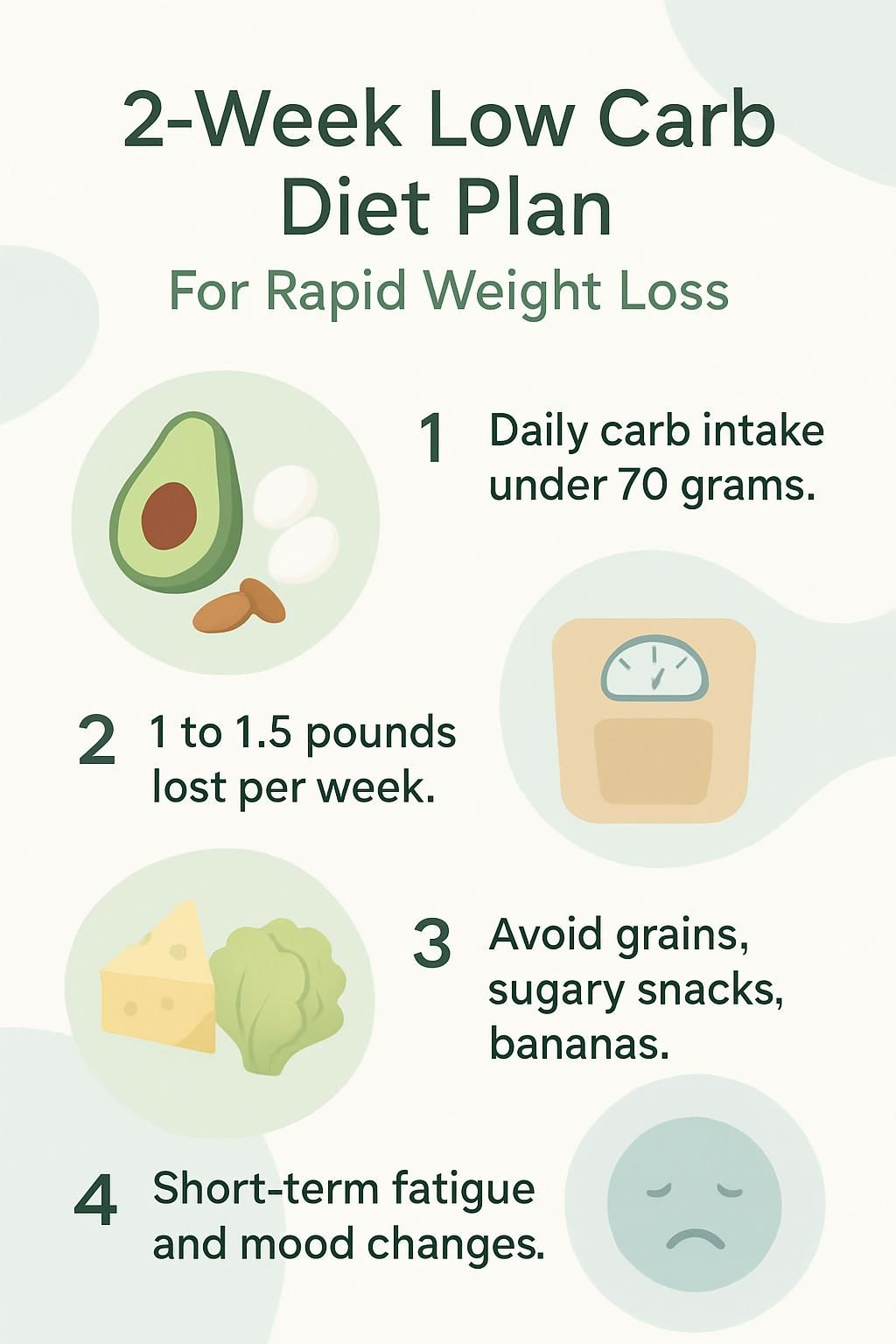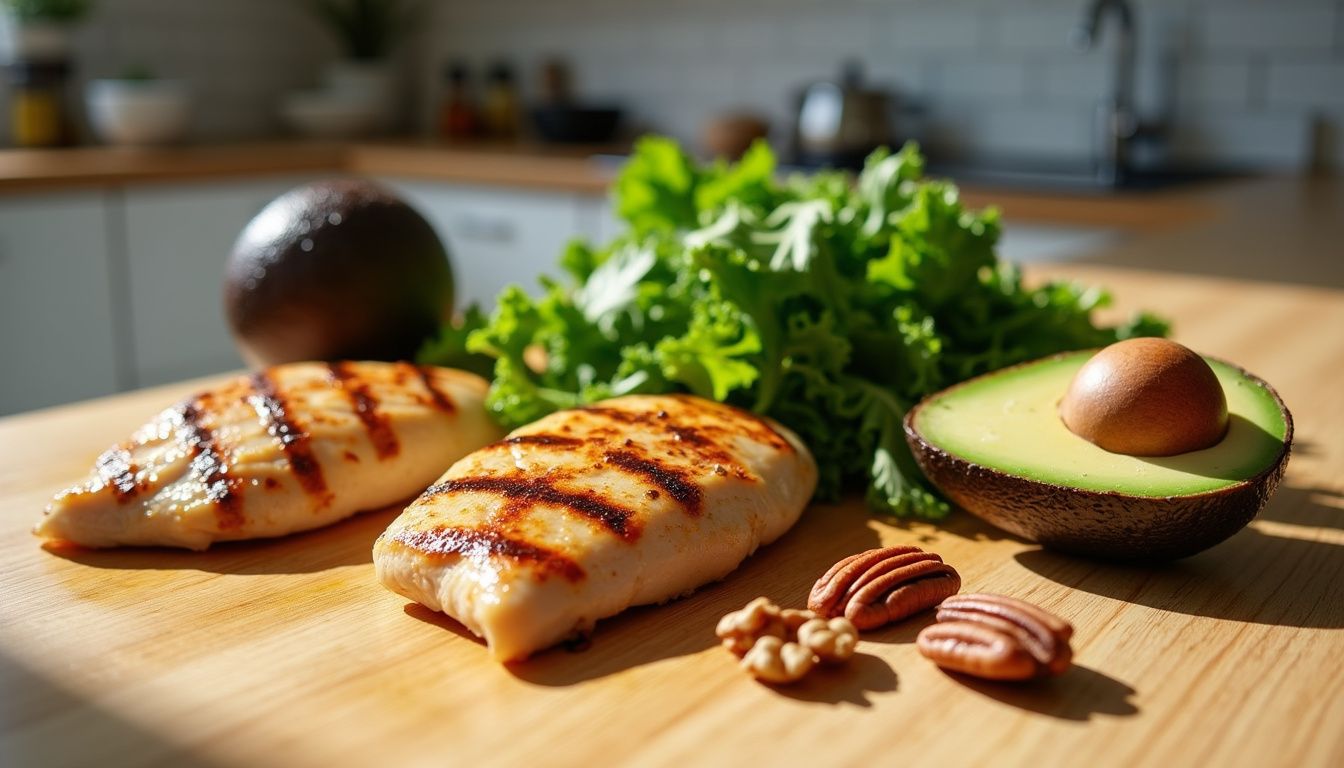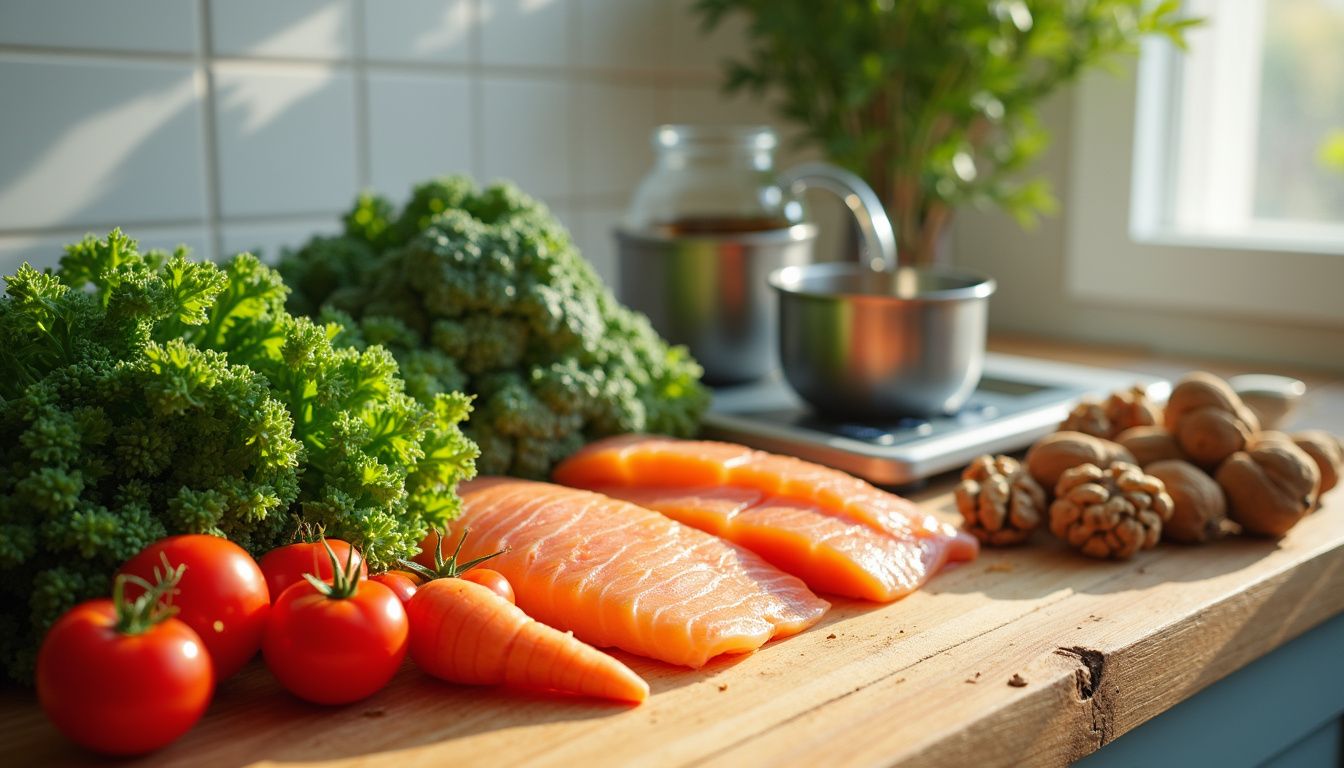2-Week Low Carb Diet Plan For Rapid Weight Loss
Our Nutrition Assistant AI Suite will transform your body. You will lose fat, get toned, and build muscle. Gain confidence and optimal health.
Struggling to lose weight even with effort and willpower? A short low-carb diet plan can jump-start progress by cutting carbs and shifting your body to burn fat for energy.
This guide explains how low carbohydrate diets work, what to eat, what to skip, and the likely benefits and risks over two weeks. You will see clear steps, simple science, and practical meal ideas to support your weight loss goals.
Key Takeaways
- A 2-week low-carb diet plan typically keeps carbs under 70 grams per day. Early weight loss often comes from water and glycogen, then fat loss follows.
- Many people see 1 to 1.5 pounds per week after the first days. Some also improve blood sugar control, especially those with insulin resistance.
- Focus on lean proteins, healthy fats, and non-starchy vegetables. Avoid sugary snacks, grains, and carb-heavy fruits like bananas and grapes to prevent blood sugar spikes.
- Short-term side effects can include fatigue, constipation, and mood changes. Long-term strict restriction can lead to nutrient gaps or hormonal shifts.
- Stable results need balanced nutrition and an ongoing plan beyond two weeks. A Registered Dietitian can tailor guidance for safe, lasting weight management.

What Are Low-Carb Diets and How Do They Work?

A low-carb diet limits carbohydrate-rich foods like bread, pasta, rice, starchy vegetables, and sweets. You center meals on lean proteins, healthy fats such as olive oil and butter, non-starchy vegetables like spinach and zucchini, eggs, cheese, and meats.
Reducing carbs pushes your body to use stored fat instead of glucose. This shift is called ketosis. Many plans aim for under 130 grams of carbs per day, while stricter versions limit to under 70 grams.
Popular approaches fit this idea. The ketogenic diet is very low in carbs. Atkins and the South Beach Diet set different carb levels in phases. The Dietary Guidelines suggest 45 to 65 percent of calories from carbs, which is higher than most low-carb approaches.
For fast results in two weeks, strict plans may drop to 20 to 57 grams per day. That is 80 to 240 calories from carbs. Many people also notice feeling fuller after swapping bread or pasta for salads with grilled protein.
Cutting out extra sugar was tough at first but seeing steady progress made it worth it.
Early weight loss is common because your body uses glycogen, the stored form of glucose in your muscles and liver. Glycogen binds water. As it drops, water leaves too, then fat loss becomes a larger share of progress.
There is no single carb target that fits everyone. The right number depends on your health, activity level, and how your body responds to carbohydrate restriction.
How Does a Low-Carb Diet Help You Lose Weight?
Low-carb eating supports weight loss by reducing carbs and often calories. Studies comparing low-carb versus low-fat plans show strong results for body weight in the first weeks.
How Does Reducing Calories Affect Weight Loss?
Eating fewer calories than your body uses leads to weight loss. A daily deficit of 500 to 750 calories often results in about 1 to 1.5 pounds lost per week, which aligns with safe weight management and improved heart health risk.
Sample low-carb meal plans range from about 1,225 to 1,554 calories per day. For instance, one sample day may provide 1,238 calories with controlled carbs and higher protein, while another day offers about 1,225 calories built around lean meats and vegetables.
Combining a calorie deficit with lower carbs speeds early changes. Your body burns through glycogen and sheds water in the first days, then continues with fat loss.
What Is the Role of Glycogen and Water Weight Loss?
After you start a 2-week low carb diet plan, the body uses glycogen stored in the liver and muscles. Each gram of glycogen binds roughly three to four grams of water.
As glycogen declines, your kidneys release this water. The scale may drop by several pounds in the first week, mostly from water, not fat. Many people see two to ten pounds down at first when grains and added sugars are limited.
Once glycogen is lower, weight loss slows to a more steady pace as fat burning takes the lead.
During my first low carb meals week, I lost almost five pounds of water weight before noticing actual fat changes.
These early shifts can feel dramatic, but they reflect normal biology when you cut carbs.
How Does a Low-Carb Diet Boost Fat Burning?
After glycogen drops, the body increases fat use for energy. Keeping carbs under about 50 grams per day can lead to ketosis. In ketosis, the liver turns fat into ketone bodies, which serve as fuel.
Many people lose weight quickly in this state. Research also shows better blood sugar control for some people with type 2 diabetes. Short-term side effects can include bad breath and brief fatigue while you adapt.
Is Rapid Weight Loss on a Low-Carb Diet Safe?
Rapid weight loss can be safe for many healthy adults, yet it has trade-offs. Understanding the short-term and long-term effects helps you plan wisely.
What Are the Short-Term Safety Considerations?
Fatigue, mental fog, and mood swings are common in the first days. Your body is adjusting to fewer carbs. Constipation can appear if fiber drops too low when you cut fruit, beans, and whole grains.
Early loss on the scale is mostly water tied to glycogen. Exercise may feel harder at first, especially high-intensity training that relies on quick energy from carbs. Ketosis can bring bad breath and extra tiredness on strict plans.
Staying hydrated eases headaches and constipation. Adding non-starchy vegetables helps maintain fiber intake and supports your gut health during the shift.
What Are the Long-Term Health Effects?
Long stretches of strict carb restriction can create nutrient gaps. Vitamin C, magnesium, potassium, and fiber may fall short if food variety is limited. Deficiencies can harm immunity, mood, and digestion.
Very low-carb patterns may affect hormones for some people. Women sometimes report menstrual changes. Higher protein without medical oversight may stress kidneys if you have kidney disease.
Weight often creeps back if you return to old habits. Planning for maintenance with balanced meals makes long-term success more likely.
Which Foods Should You Eat on a Low-Carb Diet?
Low-carb eating is easier with a clear grocery list. Build your plate with lean proteins, healthy fats, and non-starchy vegetables.
What Are the Best Lean Proteins to Include?
Protein helps control hunger, protects muscle, and supports steady blood sugar. Choose these options often:
- Beef steak, such as sirloin or round, offers protein and iron with less fat when you pick lean cuts.
- Skinless chicken breast provides about 26 grams of protein per 3 ounces and cooks fast for busy days.
- Pork tenderloin is lean with under 3 grams of fat per 3-ounce serving, yet still satisfying.
- Turkey breast gives about 24 grams of protein with very little fat, a heart-smart choice.
- Salmon supplies protein and omega-3 fats that support heart health.
- Eggs deliver about 6 grams of protein each with very few carbs and are convenient.
- Seafood like shrimp or cod is high in protein and low in carbs with key minerals.
- Lamb loin or leg offers rich flavor with less fat than fattier cuts.
- Deli meats such as turkey or roast beef can work, if low in added sugar and sodium.
- Tofu provides a plant-based protein option that fits many meal styles.
- Eggs, beef, chicken, pork, fish, and seafood help maintain strength during calorie restriction or intermittent fasting.
Which Healthy Fats Are Recommended?
Healthy fats improve fullness and flavor while supporting heart health. Include a variety of these sources:
- Avocados supply potassium, fiber, and monounsaturated fats that support appetite control.
- Olive oil and avocado oil fit cooking and salads, and support healthy triglyceride levels in studies.
- Nuts and seeds, such as almonds, walnuts, chia, and flaxseeds, add fats, protein, and minerals.
- Coconut oil or butter can handle higher heat when roasting or scrambling eggs.
- Fatty fish like salmon, sardines, and mackerel bring omega-3s linked to heart and metabolic health.
- Full-fat dairy like cream, cheese, and milk in moderation can boost satiety.
- Mayonnaise or simple sauces made with healthy oils add flavor without extra carbs.
What Non-Starchy Vegetables Should You Choose?
Non-starchy vegetables keep carbs low while delivering fiber, vitamins, and minerals. They also help manage hunger.
- Tomatoes offer vitamin C and potassium with about 5 grams of carbs per cup.
- Lettuce is extremely low in carbs and works with any meal.
- Asparagus is rich in folate and vitamin K with about 2 grams of net carbs per half cup.
- Spinach has about 1 gram of net carbs per cup raw, plus iron and antioxidants.
- Green beans provide around 4 grams of net carbs per cup cooked and are filling.
- Broccoli supplies fiber, vitamin C, and about 4 grams of net carbs per cup cooked.
- Celery sticks are a quick snack with under 1 gram of net carbs per stick.
Choosing these vegetables helps reduce glycemic load, steady insulin, and support weight loss.
Which Foods Should You Avoid on a Low-Carb Diet?
Foods high in sugar and starch drive quick blood sugar spikes and can slow fat loss. Limiting them strengthens your results.
Why Avoid Sugary Snacks and Desserts?
Sugary snacks and desserts pack added sugar. Frequent intake raises the risk for weight gain, type 2 diabetes, high blood pressure, unhealthy cholesterol, and dental issues.
Skip sugary drinks and be careful with sweeteners if they trigger cravings. Whole fruit can satisfy a sweet tooth with more fiber. Spices like cinnamon or nutmeg add flavor without sugar.
Why Eliminate Grains and Starchy Vegetables?
Grains such as bread, rice, pasta, and oats are major carb sources. Starchy vegetables like potatoes, corn, peas, and yams also add many carbs per serving. Cutting these helps your body rely more on fat for fuel, which supports ketosis.
Restricting starches drains glycogen and water in the first week, which can move the scale quickly. Many people also find hunger is easier to manage without big blood sugar swings.
Which High-Carb Fruits Should Be Limited?
Bananas, grapes, and mangoes carry higher natural sugars. One medium banana has about 27 grams of carbs. A cup of grapes has about 26 grams. A whole mango can approach 50 grams.
If you follow a low-carb diet for weight loss or prediabetes, these fruits can push you over your daily limit. Berries are easier to fit. For example, a cup of strawberries has about 12 grams of carbs.
What Does a Detailed 2-Week Low-Carb Diet Plan Look Like?
This 2-week outline gives structure and variety while keeping carbs low. Adjust portions to meet your calorie needs and activity level.
What Are Good Meal Ideas for Day 1?
- Breakfast: Scrambled eggs cooked in butter with tomatoes or lettuce for extra fiber and vitamins.
- Snack: Almonds for steady energy and hunger control.
- Lunch: Chicken cooked in coconut oil with asparagus for lean protein and crunch.
- Dinner: Salmon with sautéed spinach for omega-3s and iron.
- Daily targets: About 1,554 calories, 94 grams fat, 119 grams protein, and 52 grams carbs.
- Beverages: Water or unsweetened tea to avoid hidden sugars.
- Tip: Keep flavors bold to reduce cravings on day one.
What Are Good Meal Ideas for Day 2?
- Breakfast: Turkey pickle sandwich using lettuce wraps to cut bread carbs.
- Snack: A handful of macadamia nuts for healthy fats and fullness.
- Lunch: Protein bowl with grilled chicken, leafy greens, and olive oil.
- Snack: Celery sticks with almond butter for fiber and healthy fats.
- Dinner: Meatballs over roasted spaghetti squash with low-carb tomato sauce.
- Drinks: Black coffee or herbal tea add no carbs.
- Hydration: Water with lemon supports digestion and appetite control.
What Are Good Meal Ideas for Day 3?
Day 3 stays simple and satisfying with about 1,238 calories, 64 grams fat, 87.7 grams protein, and 69 grams carbs.
- Breakfast: Spinach omelet cooked in butter for protein and fiber.
- Snack: Celery sticks to manage hunger between meals.
- Lunch: Salmon with green vegetables to support healthy cholesterol.
- Dinner: Beef steak with asparagus for iron and recovery.
- Fluids: Water or unsweetened herbal tea throughout the day.
- Fruit: Limit high-sugar options like bananas to keep carbs in check.
- Carb swaps: Skip grains and starchy vegetables to maintain fat burning.
- Protein picks: Eggs, salmon, or steak for steady energy.
- Evening: A small handful of nuts beats sugary desserts.
- Tracking: Use an app or journal to monitor calories and macros.
Many people report better energy after switching from toast to a protein-rich breakfast.
What Are Good Meal Ideas for Day 4?
Meals total about 1,225 calories, 60.4 grams fat, 106.1 grams protein, and 66.6 grams carbs.
- Breakfast: Scrambled eggs in olive oil with spinach and chopped tomatoes.
- Snack: A handful of mixed nuts for healthy fats and satiety.
- Lunch: Grilled chicken breast with a salad of greens, cucumbers, and avocados plus olive oil vinaigrette.
- Snack: Sliced turkey rolled around avocado for protein and fiber.
- Dinner: Grilled salmon with roasted zucchini and asparagus.
- Dessert: Plain Greek yogurt with cinnamon to limit added sugar.
- Hydration: Water or unsweetened tea to support digestion and energy.
- Flexibility: Swap proteins or vegetables to keep meals interesting.
Prepping lean proteins ahead of time makes it easier to avoid high-carb snacks.
What Are Good Meal Ideas for Day 5?
Day 5 targets about 1,231 calories, 81.2 grams fat, 92.1 grams protein, and 32 grams carbs.
- Breakfast: Two scrambled eggs in olive oil with avocado and spinach.
- Snack: Mixed nuts such as almonds or walnuts.
- Lunch: Grilled chicken breast with roasted broccoli or cauliflower.
- Snack: Celery sticks with cream cheese.
- Dinner: Baked salmon with lemon, steamed asparagus, and a leafy green salad with extra virgin olive oil.
- Dessert: A small portion of plain Greek yogurt if desired.
- Fluids: Water or unsweetened tea for hydration.
- Variety: Rotate meats such as turkey or bacon to keep interest.
- Balance: Keep portions steady to match your goals.
- Restriction: Skip sugary snacks and high-carb fruits.
- Prep: Cook once for multiple meals to stay on track.
What Are Good Meal Ideas for Day 6?
Repeat favorites and add a few twists for variety. Aim for lean protein, healthy fats, and plenty of non-starchy vegetables.
- Breakfast: Omelet with eggs, spinach, and bell peppers, topped with a little shredded cheese.
- Snack: Almonds or walnuts to steady energy.
- Lunch: Grilled chicken over romaine or kale with avocado and olive oil dressing.
- Snack: Celery with nut butter or a hard-boiled egg.
- Dinner: Baked salmon with lemon and herbs with roasted broccoli and zucchini.
- Dessert: Cottage cheese with a few raspberries or blackberries for a lower-carb fruit option.
- Hydration: Drink water often to reduce cravings and support mood.
Protein-rich meals and nuts can reduce cravings and help you stay within your carb limit.
What Are Good Meal Ideas for Day 7?
Keep carbs under 70 grams. Focus on simple meals that support heart health and steady energy.
- Breakfast: Scrambled eggs in olive oil with sautéed spinach and sliced avocado.
- Lunch: Grilled chicken breast with a large salad of romaine, cucumbers, tomatoes, and walnuts with olive oil vinaigrette.
- Snack: Plain Greek yogurt topped with chopped almonds for protein and calcium.
- Dinner: Broiled salmon with lemon and herbs, served with steamed broccoli and roasted bell peppers.
- Fluids: Water or herbal tea throughout the day for hydration.
- Dessert: A few raspberries or blackberries for fiber and vitamins.
- Evening snack: A hard-boiled egg or celery with hummus if still hungry.
This routine supports mood, energy, and weight loss through your first week.
What Are Some Suggestions for Week 2?
Week 2 builds on progress with small changes that prevent boredom and keep momentum.
- Rotate proteins such as chicken, turkey, fish, and tofu to add variety while managing calories.
- Keep daily carbs below 70 grams to support fat burning if your doctor agrees.
- Use different healthy fats, like olive oil, avocado oil, or coconut oil, to improve fullness.
- Fill half your plate with non-starchy vegetables at each meal.
- Snack on nuts in measured portions to control calories.
- Plan breakfasts with eggs in different styles, such as scrambled, boiled, or omelets.
- Mix up lunch salads with various greens and lean proteins like salmon or turkey.
- Cook simple one-pan dinners, for example beef with stir-fried vegetables or baked cod with cauliflower rice.
- Track energy and mood to see how your body responds to the plan.
- Drink water often to aid digestion and curb cravings.
These small adjustments help you stay consistent while keeping meals enjoyable.
Benefits of Following a Two-Week Low-Carb Diet
A two-week low-carb plan can spark weight loss, stabilize energy, and reduce cravings. Many also see better control of blood sugar during this period.
How Does It Promote Quick Weight Loss?
Lower carbs reduce glycogen stores, and water tied to glycogen leaves with it. People commonly see 2 to 5 pounds per week at first. As carb intake stays low, your body uses more stored fat for energy.
Less bloating and fluid retention often make clothes fit better within days. Cutting calories and increasing fat metabolism together speed early change.
How Does It Help Control Blood Sugar Levels?
Fewer carbs mean smaller spikes after meals. Insulin has less work to do, which can support healthy blood sugar patterns and lower the chance of metabolic syndrome. Some people also notice drops in blood pressure and better cardiometabolic health.
Stable blood sugar can improve mood and focus. A lunch built on lean protein and healthy fats tends to avoid the afternoon crash.
How Does It Reduce Food Cravings?
Protein and fat improve fullness hormones that keep hunger in check. Without added sugar, blood sugar rises and falls more gently. Stable levels reduce the urge to snack between meals.
Structured meal plans make choices simpler, which helps you stay consistent.
How Does It Boost Energy Levels?
Switching from carbs to fat for fuel can lead to more stable energy during the day after the initial adjustment. You avoid sharp highs and lows tied to high-sugar meals.
Many report clearer thinking once adapted. Meals with protein and healthy fats deliver steady fuel without frequent snacking. Some studies suggest these effects relate to stable blood sugar and sustained fat metabolism [1][2].
What Are the Risks of a Low-Carb Diet?
Low-carb plans are not ideal for everyone. Risks can affect nutrients, digestion, energy, and social life.
What Are the Risks of Nutrient Deficiencies?
Cutting many fruits, beans, and grains can lower vitamin C, magnesium, potassium, and fiber. These nutrients support immunity, nerves, and digestion. Over time, low intake may lead to cramps, fatigue, or bowel issues.
Adults need at least 25 grams of fiber daily for digestive health, according to many nutrition guidelines. Falling short raises the chance of constipation. Supplements may help if food variety is limited, but food-first strategies are best.
Can It Cause Digestive Problems?
Constipation is common early on because fiber often drops. Limiting plant foods can reduce helpful prebiotic fibers that feed good gut bacteria. This can cause bloating or irregular stools for some people.
Extra water, leafy greens, nuts, and seeds support regularity. Non-starchy vegetables like spinach and broccoli can help you meet fiber needs while keeping carbs low.
How Does It Affect Energy and Exercise Performance?
Carbs fuel fast, intense exercise. When you first cut carbs, workouts can feel harder. Fatigue, mental fog, and low motivation may appear during the first week as your body adapts.
High-intensity performance often dips in the first 7 to 14 days of low-carb eating. Rapid early water loss may make muscles feel weaker. As adaptation improves, daily activity usually feels easier again.
What Are the Social and Lifestyle Considerations?
Eating out can be tricky because many meals come with bread, pasta, or rice. Special requests help, yet it can feel isolating if group meals revolve around high-carb foods.
Repetitive menus may cause boredom and increase the risk of quitting the plan or overeating later. Highly restrictive rules can trigger disordered patterns in some people. Studies show about 30 percent of adults on strict plans report feeling left out during group meals by week two^1^.
What Are the Best Strategies for Success on a 2-Week Low-Carb Diet?
Simple systems make this plan easier. Focus on meal prep, hydration, tracking, and timely support from experts.
How Can Meal Prepping Improve Your Diet?
Meal prepping lets you control ingredients and keep carbs under your target. It also saves time and prevents last-minute choices that are high in sugar and starch.
Rotate proteins and vegetables to avoid boredom. A prepped lunch in the fridge makes it easier to skip fast food and stay within your goals.
Why Is Staying Hydrated Important?
As glycogen drops, your body releases more water. You may urinate more often and feel thirsty. Drinking enough fluids reduces headaches, aids kidneys, and helps prevent constipation.
Black coffee and unsweetened tea count toward fluids without adding carbs. A glass of water before meals can also help control appetite.
How Should You Monitor Your Progress?
Track daily calories, protein, fat, and carbs to see how closely you follow the plan. For example, log a day with 1,554 calories, 94 grams of fat, 119 grams of protein, and 52 grams of carbs.
Weigh yourself on a schedule, such as once or twice per week. Expect faster changes in week one due to water, then slower steady loss. Note energy, mood, and digestion. Patterns help you adjust before problems grow.
When Should You Consult Health Professionals?
Talk to your doctor before starting if you have medical conditions or take prescription medicines. Seek help if you notice severe fatigue, dizziness, heart palpitations, digestive distress, or rapid unplanned weight loss.
Registered Dietitians can tailor plans to your needs and budget. Pregnancy and breastfeeding require special care, so medical guidance is essential in those stages.
What Common Mistakes Happen on Low-Carb Diets and How Can You Avoid Them?
Small errors can stall progress. Spot hidden carbs, eat on a schedule, and hit your protein and fat targets.
How to Identify Hidden Carbs?
Read labels on packaged foods. Look for added sugars and starches such as maltodextrin, corn syrup solids, and honey. Even sugar-free items may contain sugar alcohols or thickeners that raise carbs.
Grains, starchy vegetables, and sauces often hide extra carbs. A small serving of a creamy dressing can add 5 to 10 grams. Checking the full ingredient list prevents surprises.
Why Should You Avoid Skipping Meals?
Skipping meals can cause fatigue, mental fog, and mood swings. Regular protein and healthy fats keep energy steady while your body adapts.
Missed meals also raise the risk of overeating later. A steady routine supports focus and cuts cravings.
How to Ensure Adequate Protein and Fat Intake?
Include a protein source at each meal, such as chicken, fish, eggs, beef, pork, or turkey. A sample day with about 119 grams of protein helps maintain muscle and improves fullness.
Add healthy fats like olive oil, avocado oil, coconut oil, butter, nuts, and seeds to reach your targets. Track intake with a food diary or app so you can adjust in real time.
Who Should Avoid Following a Low-Carb Diet?
Some people should not follow strict low-carb plans. Safety comes first, especially with medical conditions or special life stages.
Why Should Pregnant or Breastfeeding Individuals Be Cautious?
Pregnancy and breastfeeding raise needs for folic acid, iron, calcium, and fiber. Cutting key food groups can limit these nutrients and may affect growth or milk supply.
Calorie needs also increase. Very low-carb patterns can reduce energy and limit glucose for brain development. Balanced eating, guided by a clinician, is safer during these times.
Which Health Conditions Exclude Low-Carb Diets?
People with chronic kidney disease often need to limit protein. A high-protein, very low-carb plan can strain kidneys further.
If you have a history of eating disorders, strict plans may trigger relapse. Those with digestive diseases, like irritable bowel syndrome or Crohn’s disease, may worsen symptoms if fiber becomes too low. Consult your doctor before changing your diet.
Conclusion
A 2-week low-carb diet plan can deliver rapid weight loss and renewed motivation. You shift from high-carb foods to lean proteins, healthy fats, and non-starchy vegetables. That change encourages fat burning while often improving blood sugar stability and reducing cravings.
Short plans are a start, yet long-term health needs balance and a plan you can maintain. If you want support and a personalized path, consider working with a Registered Dietitian. Thoughtful guidance helps you keep the progress you worked hard to achieve.
Health information in this article is for education only and is not a substitute for medical advice. Consult a qualified professional for personal guidance. Credible sources include the U.S. Dietary Guidelines and peer-reviewed nutrition research.
FAQs
1. What is a 2-week low carb diet plan for rapid weight loss?
A 2-week low carbohydrate eating plan limits foods high in starches and sugars, such as bread, pasta, rice, and sweets. The goal is to help the body burn stored fat for energy instead of relying on carbohydrates. Research shows that reducing carbs can lead to faster initial weight loss compared to standard calorie-restricted diets (Bazzano et al., Annals of Internal Medicine, 2014).
2. How many grams of carbohydrates should I eat each day on this plan?
Most effective plans recommend consuming between 20 to 50 grams of net carbs per day during the first two weeks. Net carbs are calculated by subtracting fiber from total carbohydrates. For example, one cup of broccoli contains about six grams of total carbs but only two grams of net carbs due to its fiber content.
3. What foods can I eat on a low carb diet for rapid weight loss?
You may include lean meats like chicken breast or turkey; fatty fish such as salmon or mackerel; eggs; non-starchy vegetables including spinach, cauliflower, and zucchini; nuts; seeds; olive oil; and some dairy products like Greek yogurt or cottage cheese with no added sugar.
4. Are there any risks or side effects with a short-term low carb diet?
Some people experience fatigue, headache, constipation, or irritability during the first few days as their bodies adjust to fewer carbohydrates (Westman et al., Nutrition & Metabolism, 2007). Drinking water and eating enough salt can reduce these symptoms. People with certain health conditions should consult their doctor before starting this type of meal plan.
Summary: A structured 2-week low carbohydrate meal plan focuses on reducing starchy foods while emphasizing protein-rich options and non-starchy vegetables. This approach often leads to quick initial weight loss but may cause mild side effects as your body adapts to using fat for fuel instead of glucose from carbohydrates. Always check with your healthcare provider before making major changes to your eating habits if you have health concerns or take medication.







